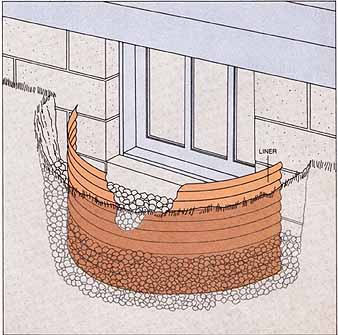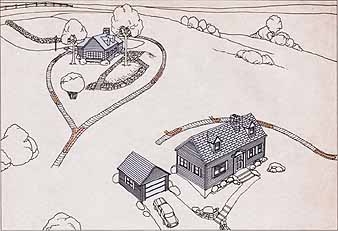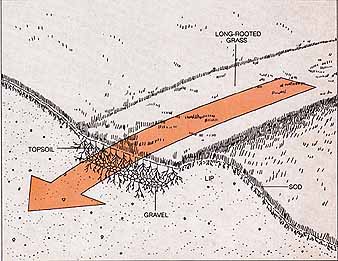Water that collects around the foundation of a house can exert tremendous pressure—as much as 500 pounds per square foot—eventually causing structural damage and wet basements. Channeling rain and melting snow away from the foundation is thus a primary concern of every homeowner.
You can protect a house located on sloping ground by digging a system of swales—drainage ditches that are planted over with grass and are so shallow they are almost unnoticeable—to collect most of the runoff and reroute it away from the foundation . Rain that falls within this defensive line can be deflected by banking earth near the house to form a sloping watershed. If the dirt would cover part of a basement window, install a window well. Do not pile dirt closer than 8 inches to wood siding, however, or insects will use the embankment as a bridge into the house. Areas directly below eaves must be protected from water coursing off the roof; raindrops can erode soil and expose the foundation. Gutters and downspouts are the common means by which this water is carried away. But these conduits are not the only solutions; indeed, they have drawbacks that the homeowner should keep in mind. They need maintenance—painting, patching, repositioning—and replacement when they wear out. They get clogged with debris. In northern climates they become blocked with snow and ice, causing buildups on the gutters and the roof itself.
Use gutters and downspouts where they are essential, but let rain fall freely off the roof if the ground below will bear it. A steep embankment often is protection enough. Thin strips of gravel, walks and patios are better still. And dense shrubbery planted under the eaves not only impedes erosion but adds a note of grace to your landscaping. Be careful, though, to avoid greenery with large root systems; the roots may grow against the foundation and crack it.
Wherever downspouts are used, the area around them must be given extra protection from the heavy concentration of water they spew forth. If the ground slopes sharply, you may need to install only a splash block that will absorb the impact and disperse the torrent. But if the house is on level ground you probably will need a downspout extension. This may be as simple as a coiled plastic pipe that unfurls under the force of running water, or it may involve underground piping and , in extreme cases, a dry well. Again, be guided by the rule that the best system is the simplest one that will get the job done.

Installing a window well. The cavity
around a basement window that extends below ground level exposes the foundation
to serious water damage unless proper drainage is provided. The solution
is a window well. The liner of an inexpensive and easy-to-install well
consists of a ready-made, oval-shaped sheet of galvanized steel, usually
corrugated. Available at building- supply stores, the sheets come in a
variety of sizes that will fit around almost any window.
Buy a liner 6 inches wider than the window. Dig a hole for the liner 1 foot deeper than the bottom of the window. Center the liner in the bottom of the hole . Spread 4 inches of gravel on the bottom of the well, both inside and outside the liner, then fill the rest of the hole behind the liner—away from the house—with earth. Plant sod or place a thin strip of gravel on top of the earth so that rain falling around the perimeter of the well will drain away naturally.
A System of Swales and Berms

Laying out drainage ditches. Plan
ditches—swales—across the slope above your house to intercept water coming
downhill, making them long enough to divert the water around the foundation.
The downhill house in this picture requires only a single curved ditch
to keep the basement dry. The uphill house needs a more elaborate system
of connecting ditches to direct water away from its downhill neighbor.

Digging a drainage ditch. Make your
ditches 2 to 3 feet wide and 6 to 10 inches deep. As you dig, pile the
dirt on the downhill side of the ditch to make a lip—a berm—to help trap
water in the ditch. Next, spread 2 or 3 inches of gravel in the ditch,
then fill it the rest of the way with topsoil, leaving the downhill lip.
Place sod over the lip and plant long-rooted grass such as Bermuda in the
ditch to hold the topsoil and gravel in place.